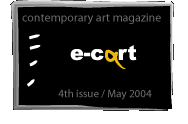
























An Interview with Johanna Billing
A couple of years ago, while I studied at the university of the Swedish town Umeň, I was working part time at Bildmuseet, the local art museum. It was a typical weekend job at museum; I was keeping an eye at the exhibitions so the visitors wouldn't touch them, children wouldn't hug the art works, which happens more often than you would think and acting as a guide. It was there, in 2001, where I first came in contact with the works of Johanna Billing (b. 1973). In one of the exhibition halls down stairs she was showing a video piece called Where she is at. The film takes place on the top of a diving tower, and I think you know the kind; one of those that are located at most beaches and I can remember seeing such diving towers from when I was young. I always found them scary and perhaps the scary thing lays in the fact that you can't possibly know for sure what's beneath the surface. For instance, the local urban legends in my hometown were of a man that had placed big, sharp, pointy wooden poles on the bottom of the lake. Any way, this could be what the girl in Where she is at is expiring. She's standing on the top undecided if she's going to make the jump or not. You can imagine that she has her friends on the beach, cheering her on, but more intensely you can follow her inner struggle with her inner self. It deals with facing your own fears and making dictions and I think it's a fantastic piece. It was the one of the art works that opened a door to video art that wasn't strained and instead was dealing with issues that was of concern in my own life.
Johanna Billing graduated from Konstfack - University College of Arts, Crafts and Design in Stockholm in 1999. At her graduation exhibition she presented the video Graduate Show, a video that was a dance performance piece. The other graduation students at Konstfack acted as the dancers and they were choreographed by Swedish choreograph/dancer Anna Vnuk. When I think of Graduate Show I can find that it's a typical work of Johanna's as she isn't afraid of entering spheres where she's a novice. Nobody of those who participated in Graduate Show are trained dancers, and you can tell that they aren't, but it takes a big piece of courage to go into a project like that without making it to some kind of joke with an ironic twist. You have to take out the brave side of yourself when you take on a new form of art, and by doing so make it for real. In most of her projects after that Johanna Billing has often worked with people who contribute with their own experiences and plays a part of the project in the capacity as them self. This is one the most intriguing things with her works I think, how she involves others and let them contribute with their own experiences and capacities in the process. In her films you can always find some angle that explores the diversities and issues that could be found in working alone in contrast to working within a group. As a viewer you're also a participant in the projects as they often are constructed around a social environment, and the essence, or what ever you call it, in the project comes from participation and interaction of people, artist, friends and audience. Her project, You don't love me yet, was a tour of Sweden where bands and musical performers were invited to perform the song You don't love me yet by the American singer and songwriter Roky Erickson. More than 100 different versions of the song were performed and recorded, but the songs in themselves were never really the main thing. At the time I was working at Index - the Swedish contemporary art foundation in Stockholm, who organised the tour, and what I found the most interesting with the project was the meetings and relationships that evolved through the project. There were musicians that never really that come close to contemporary art and there were people that never really had been in contact with the contemporary music scene, and now they had to work together. The fact that you listened to the same song over and over made you really sink into the piece, but also get closer to the ones performing. Over 100 versions, up to 20 at the time, but you'd never say that you heard this before. When different artists put their own personality in the song there will automatically turn into something unique. You can have a mental picture of how the final result will look like, but you can never be sure. As an artist Johanna hands over a large portion of the process in the hands of the people she involves in her work.
Johanna: My brother has told me; "You can't really fail, because you say that everything you do is an experiment." He thinks that in any case I'll always be satisfied, even if in the end it isn't anything like I thought it would be. And that is true in some sense. When you talk about success or failure, it is the same thing as talking about good or bad. I think it's exciting if you can look pass that when you're working. Look at it as an experiment instead of trying to make something "successful".
Anders: But at the same time, your brother has point. It can be very forgiving if your work is always a process and you just tag along and see what ever will happen.
Johanna: Let put it this way; it can be more or less interesting. I can think that some of the things I've done are more interesting than others. And that is a difference. As an artist you're often so determined to create an immediate understanding of your work. When it's finished you should be able to look at it and instantly see whether it's good or not, but you should be able to look at it in a longer perspective as well. We can sit here and talk about things I've done several years ago, and maybe it's not until now that it's really interesting, or more interesting, to talk about it. Both as an artist and the people around you, the ones writing about art, you're determined to make everything fast and you should be able to get the meaning at once. It feels like we should be reminded that that hasn't to be the case. Personally I like artists that have the courage to make experiments in that way. Some things turn out to nothing and some gets really interesting. But it's in that way with everything. All things I've done come out of the same thing; I feel that we may be living our lives in a way we were maybe not looking for in the first place. The standards that are put up by society are saying to us that we should always be striving for something, and that we should fulfil ourselves. It's there and then you discover that you are trapped in a pattern that you don't know how to get out of. I think all things I do, come out of a feeling I have, which says: How should I be able to get out of this? I start to think about why I'm feeling this way, where it all comes from and what reasons lay behind. I invite people to collaborate with me because I want to know if this feeling is valid. I invite people that may have some connection to this, and who are in the same kind of situation as I am and then they become some kind of mix between actors and regular people. I think it's important to do something that can be seen on different levels at the same time. If you do that, it's hard to immediately read it. Under a certain period it can be one specific aspect that it interesting with the project and under another period it can be something else that you remember as exciting. It's hard to write a good review at once when it's like that. I won't say that I feel misunderstood or anything, but it's been shown that it's hard to be an art critic.
In 2000 Johanna Billing produced a video called Project For a Revolution. It takes place at some sort of a meeting, perhaps political, but you can tell that it's a meeting. A group of young people are sitting, waiting in a large room. As a viewer you never learn what they are waiting for, the camera just pans over the faces and the group. Suddenly a person gets up and, for what reason we don't know, leaves the building. It's a scene which is approximately 4 minutes long and it's shown in a loop lasting approximately for 30 minutes. Project For a Revolution caused quite the stir within the Swedish art scene when it came, with some people talking about it as the perfect image of the youth of today just hanging around, without doing anything with their lives. The intentions of the film wasn't in anyway to serve as a document of the current state of politics in Sweden nor the world, but came out of rather personal thoughts concerning Johanna around her own life and the lives of her friends.
Johanna: It started when I saw this film, Zabriskie Point, by Michelangelo Antonioni, just when I had graduated from Konstfack. The first scene of the film is a scene you will remember as typical of the political meetings of the 1960's. When you see those images I can feel that I also want to have that feeling of belonging to something. At the same time I felt that feeling was rather common among a lot people in the end of the 90's, and that became especially obvious when movements like Reclaim the city started to protest in the streets of Stockholm. There was a lot of energy going around and people were and are doing things all the time, but they were working in small groups. They started record labels, made fanzines and were working like madmen, but you can't really discuss the big issues if you don't get together with people from other fields. As long as you only have one perspective of things and only talk to people with the same interests there will never be a real discussion. But I'm interested in this image of the political movement we all carry around with us, and it felt like the older generations always have accused the youth of being lazy and not involved. It's because they carry around the same image of their own times, as measure of how things should look like. They aren't able to see that it's not true that young people aren't involved with the society around them. My film was a way of portraying the frustrated feeling surrounding this image, and not showing everybody how lazy we are. That's a part of it, of course, because they aren't doing anything, but I'm interested in the mental image of political struggle we have, and its relation to the older generations and us. When I made this film it was about something that happened right here and then. The reason to why it's silent is because it deals with being stuck in something and it's made as a loop as well, so it's sort of a never ending waiting. But I also made it to a silent film because I felt that you couldn't really talk about these issues. You were either involved or you were not, and when the newspapers wrote about Reclaim the streets, it was really one sided. I wanted people to start talking about it, and there were some discussions because it's a picture that you will react strongly to. You will either recognise yourself or you will absolutely not recognise yourself. If you don't you'll take it as a provocation instead, saying that you're absolutely not in that way. But it's not a documentary. All I wanted to document was this feeling of frustration that was present in the room. That feeling may have something to do with reality, but it's not an image that shows the state of thing.
The work of Johanna Billing is a constant investigation of the systems that constitute our society. She asks questions concerning why we are living our lives in the way we are, and if this really is a choice we have made freely. When she does it in forms like the project of You don't love me yet, it embarks into a journey that reaches far out of the art world, focusing on relationships and discussions. You take on her work out of two different angles, where one is the "work of art", such as the film, and the other is to focus on the thoughts, idea and questions that arise when you look at it. These things evolve into something bigger when you get in contact with others and start to talk with them. This became especially obvious with You don't love me yet, which grew into some rather wonderful because of the new relationships that were formed during the tour. It created new ways of looking at art, new ways of listening to music, and new ways of talking of these things. It is when your own impressions meet other people's impressions and you talk about them that art can grow beyond the gallery walls and become a necessity in "real life" society. And she's not playing it safe. I find her curiosity exciting, and it's of value to investigate things in the world, that you're unsure of, disregarding your own abilities in the field. It's all about taking just one leap off the diving tower.
Anders Jansson
|
|
 |
 |
|
|||||||||||||||||||||||
 |
|
 |
|
|||||||||||||||||||||||
|
|
|
|||||||||||||||||||||||||
|
|
|
 |
|
|
||||||||||||||||||||||
|
|
 |
|
|
|||||||||||||||||||||||
 |
 |
 |
|
|||||||||||||||||||||||
|
|
|
|
||||||||||||||||||||||||
|
|
 |
|
 |
|
||||||||||||||||||||||
 |
|
|||||||||||||||||||||||||
| |
|
 |
 |
|
||||||||||||||||||||||
 |
|
|
|
|||||||||||||||||||||||
|
|
|
|||||||||||||||||||||||||
| |
|
|||||||||||||||||||||||||
|
|
 |
|
||||||||||||||||||||||||
|
|
|
|||||||||||||||||||||||||
|
|
|
|||||||||||||||||||||||||
 |
|
|||||||||||||||||||||||||
 |
 |
|
|
|||||||||||||||||||||||
|
|
 |
 |
|
|||||||||||||||||||||||
|
|
|
|
||||||||||||||||||||||||
 |
|
 |
|
 |
|
|
||||||||||||||||||||
 |
|
|||||||||||||||||||||||||
|
|
|
|
|
|||||||||||||||||||||||
|
|
|
|
|
|
|
|
|
|
|
|
|
|
|
|
|
|
|
|
|
|
|
|
|
|
|
|